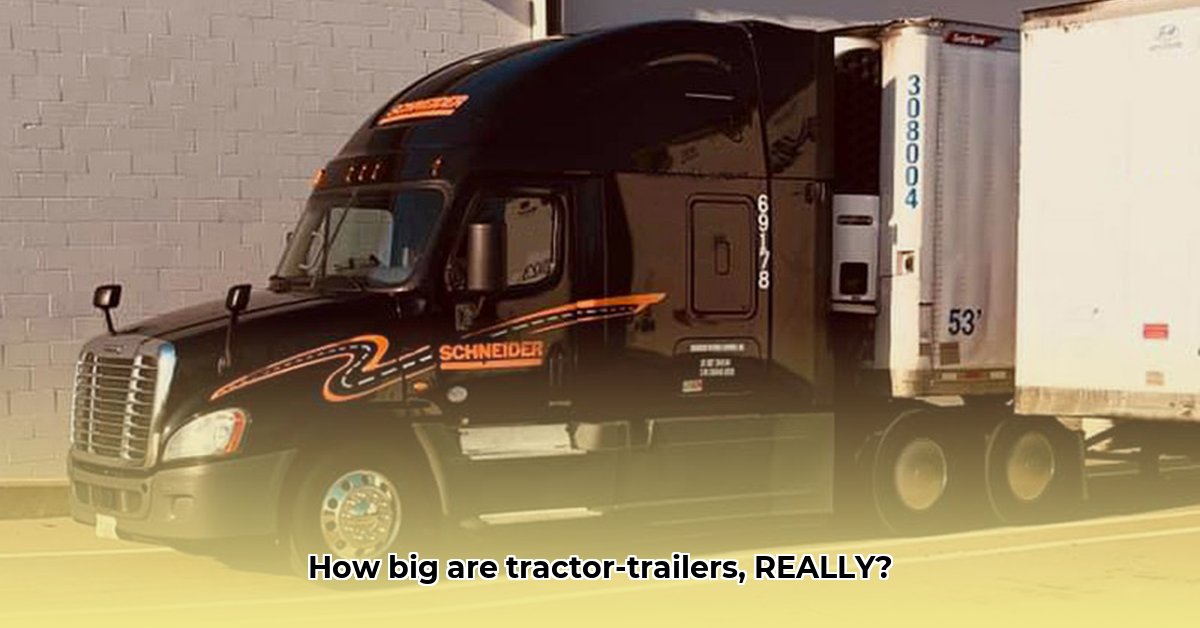
Ever wondered about the sheer size of those 18-wheelers rumbling down the highway? It's more than just a simple height question. The dimensions of tractor-trailer trucks—length, width, and height—are surprisingly complex, governed by a patchwork of federal and state regulations with significant impacts on logistics, costs, and infrastructure. For more detailed information on standard lengths, check out this helpful resource: Standard Tractor Trailer Lengths. This comprehensive guide clarifies the standard dimensions, variations by trailer type, state-level regulations, oversized load procedures, and the future of trucking dimensions.
Standard Dimensions: The Baseline
A standard semi-truck with a 53-foot trailer typically measures approximately 70 feet long, 8.5 feet wide, and 13.5 feet high. However, this is a generalization. The actual dimensions can vary widely based on several factors, including the type of trailer and specific modifications. This height includes both the tractor cab and the trailer itself. Adding side mirrors increases the overall width to approximately 10 feet.
Variations by Trailer Type: A Wide Range of Sizes
Trailer type significantly influences dimensions. A dry van (enclosed cargo) generally adheres to the standard 13.5-foot height and 53-foot length, while other trailer types vary considerably:
| Trailer Type | Typical Height (ft) | Typical Length (ft) | Typical Width (ft) | Notes |
|---|---|---|---|---|
| Dry Van | 13.5 | 53 | 8.5 | Standard enclosed cargo trailer. |
| Flatbed | 5-10 | 48-53 | 8.5 | Open-air; height variable depending on load. |
| Tanker | 13.5+ | 48-53 | 8.5 | Height depends on liquid/gas being transported. |
| Refrigerated | 13.5 | 53 | 8.5 | Climate-controlled; similar dimensions to dry vans. |
| Pup Trailer | 13.5 | 28 | 8.5 | Smaller trailer, often used in pairs. |
Isn't it fascinating how much variation exists? This diversity reflects the wide range of goods transported across the country.
State-Level Regulations: A Regulatory Patchwork
While federal regulations establish minimum standards, each state can impose its own restrictions, creating a complex regulatory landscape. This can lead to significant challenges for interstate carriers. For example, some states may permit longer trailers than others, necessitating careful route planning to avoid violations. Before any interstate trip, confirming the specific regulations for each state traversed is crucial.
Oversize/Overweight Loads: Permits and Procedures
Transporting loads exceeding standard dimensions or weight necessitates special permits. This involves additional paperwork, increased costs, and often requires pilot cars to escort the oversized vehicle. The permitting process varies significantly across states and requires thorough preparation and advance planning. Ignoring these regulations can lead to substantial fines and delays. How much extra would you estimate these permits cost a trucking company annually?
Impact on Operations, Costs, and Infrastructure
Variations in truck dimensions directly impact logistics, costs, and infrastructure. Larger trucks might require specific routes, while exceeding weight limits increases fuel consumption and places added stress on roads and bridges. These factors influence the overall cost of transportation and the long-term sustainability of the transportation industry.
Future Trends: The Evolving Landscape
Technological advancements, such as autonomous driving and the use of lighter-weight materials, could potentially alter truck dimensions in the future, but currently, a thorough understanding of existing regulations remains paramount.
Conclusion: Navigating the Dimensions of Trucking
Understanding the dimensions of tractor-trailer trucks and the associated regulations is crucial for efficient and compliant transportation. This involves awareness of standard dimensions, variations by trailer type, state-level regulations, and procedures for handling oversized loads. Failure to comply can lead to significant financial penalties and operational disruptions. Proactive planning, including thorough research and adherence to regulations, is key to successful trucking operations.